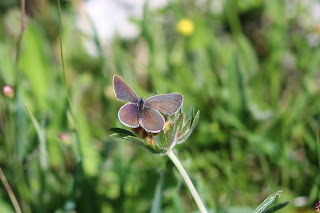How rare birds are really found
Have you ever read the latest "Finders in the Field" or, in times past "Birds new to Britain" and wondered who these superhumans are.
A typical account seems to my, perhaps jaundiced eye, goes something like this : (with apologies to DIMW )
Whilst walking past a dense patch of bushes at the Abbey on Tresco I heard a single call. Immediately recognizing this as a Northern Waterthrush, I leant down, knowing,intimately the characteristic of the species from a book I had glanced at on a friend's shelf. Within seconds I had found the bird on the ground below the vegetation and I managed to obtain the following 18 pages of detailed notes.
This is not my experience: and yesterday's Grey Phalarope illustrates what I suspect is the commoner reality. But first a proper view of it.
I had just climbed the top gate into the Seawall proper and walked immediately down to the lower gate to avoid being shot or set upon by the notoriously confrontational farmer.
As I got down to the lower gate with its barbed wire covering I noticed a wader out on the shoreline swimming a few inches out. A swimming wader ,on my patch, especially a pale one, is almost inevitably an Avocet for reasons I don't begin to understand.
This lead me to over-estimate the size and I then dashed to get my camera out as out Avocets are usually even more distant than this bird was.
Naturally my camera bag zip was stuck and I wrestled for what seemed like ages to open it.
Eventually I got the Nikon out, wound up the zoom and pointed it at the spot. At which point I got tangled in the barbed wire.
Extricating myself and very carefully re-aiming the camera I discovered the sea was, inevitably, empty !
Back to the bins and I re-found the wader on the mud but farther away and looking long-necked, very pale but clearly not an Avocet.
Up came the camera again and this time Bingo the pic below
Not wanting to waste the opportunity I fired off two more shots realising, as I did so that the bird was off. The first was no more help
I then put the camera down and lifted my bins...but the bird had simply vanished.
Examining the last pic I thought that it really did look intriguing but was still confused about the size
With the marvelous benefit of hindsight I can now only see one candidate but at the time I was genuinely confused.
Clearly no Avocet, but wait others had seen Spotted Redshank recently, but then the wingbar ruled that out. The most likely candidate was surely a Sanderling but then why did it not scream Sanderling when I had first seen it...and surely they don't swim.
I considered the bill to be a good fit for an Phalarope but it was clearly the wrong time of year so that impression could be a photographic artifact. (I was working off the back of the camera.)
Next decision was whether to send the pic to other local birders direct from the camera, via my phone and canvas opinion. In the end I decided to do the rest of the walk and put the pic up on my computer once I got home and work it out for myself.
I continued to the Yeo, passing a couple of Environment Agency staff working to repair the sluice, who were the only other people I came across the whole afternoon. At the end I poured a coffee and returned to the pics.
It was actually very Phalarope like wasn't it. But time of year and my impression of its bulk still mitigated against that. But then again, wasn't a long neck indicative of Wilsons Phalarope. The problem was I have not seen one of these for many years, so it was back to a bigger screen and a book as the best option.
I trecked back along the seawall until I had almost reached the track inland to the car when I noticed a bird on the sea a few yards out from the rocky wall. Somehow the change of perspective made it obvious. It was very clearly a Grey Phalarope and looked like nothing else. It was behaving, like one, in the habitat for one and the size, this time, was spot on.
I quickly got a few photos
And then some video
Within a couple of minutes I had let a few patch watchers know, and I then sent out a tweet once I got to the car and could comfortably transfer images.
So what did I learn,
Getting pics is always a good idea even if they don't all help
Always be alert to the possibility of the unusual
Accept that perceptions can be wrong
Keep at it, despite days and days without anything unusual, there is always a chance
Usually the guys who nail the very tricky birds....they really are that good but with constant practice by the time I hit my 200th birthday I will be at least 10% that good..... remember there is always a chance
I hope that this inspires at least one patch watcher to stick to the effort required when it all seems a waste of time.










Comments
Post a Comment